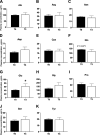Excess dietary Lys reduces feed intake, stimulates jejunal CCK secretion and alters essential and non-essential blood AA profile in pigs
- PMID: 38369505
- PMCID: PMC10874532
- DOI: 10.1186/s40104-023-00971-9
Excess dietary Lys reduces feed intake, stimulates jejunal CCK secretion and alters essential and non-essential blood AA profile in pigs
Abstract
Background: Commercial diets are frequently formulated to meet or exceed nutrient levels including those of limiting essential amino acids (AA) covering potential individual variations within the herd. However, the provision of dietary excess of AA, such as Lys, may lead to reduced appetite and growth in pigs. The mechanisms modulating these responses have not been extensively investigated. This study evaluated the effect of Lys dietary excesses on performance and satiety biomarkers in post weaning pigs.
Methods: Twenty-four pigs aged 21 d and weighing 6.81 ± 0.12 kg (mean ± SEM) were individually housed and offered 1 of 4 dietary treatments for 3 weeks: a diet containing a standardized ileal digestible Lys reaching 100% (T0), 120% (T1), 150% (T2) or 200% (T3) of the NRC (2012) requirements. At the end of the experiment, blood samples from the cephalic vein of the T0 and T3 groups were obtained for AA analysis. In addition, primary intestinal cultures from T0 pigs were used, following their humane killing, to evaluate the effect of Lys on gut hormone secretion and AA sensors gene expression under ex vivo conditions.
Results: Feed intake was linearly reduced (P < 0.001) and the weight gain to feed ratio reduced (P < 0.10) with increased dietary levels of Lys during the third- and first-week post weaning, respectively. Cholecystokinin concentration (P < 0.05) and the metabotropic glutamate receptor 1 and the solute carrier family 7 member 2 (P < 0.10) gene expression was enhanced in proximal jejunum tissues incubated with Lys at 20 mmol/L when compared to the control (Lys 0 mmol/L). Plasma Lys and Glu (P < 0.05) concentration increased in the T3 compared to T0 pigs. In contrast, plasma levels of His, Val, Thr, Leu (P < 0.05) and Gln (P < 0.10) were lower in T3 than T0 pigs.
Conclusion: The present results confirm that excess dietary Lys inhibits hunger in pigs. Moreover, the results provide evidence of pre- and post-absorptive mechanisms modulating these responses. Lys dietary excesses should be narrowed, when possible, to avoid negative effects of the AA on appetite in pigs.
Keywords: Amino acid; Blood; Cholecystokinin; Feed intake; Lysine; Pig; Satiety.
© 2024. The Author(s).
Conflict of interest statement
The authors declare that they have no competing interests.
Figures




Similar articles
-
Leucine (and lysine) increased plasma levels of the satiety hormone cholecystokinin (CCK), and phenylalanine of the incretin glucagon-like peptide 1 (GLP-1) after oral gavages in pigs.J Anim Sci. 2023 Jan 3;101:skad175. doi: 10.1093/jas/skad175. J Anim Sci. 2023. PMID: 37233611 Free PMC article.
-
An oral gavage of lysine elicited early satiation while gavages of lysine, leucine, or isoleucine prolonged satiety in pigs.J Anim Sci. 2022 Dec 1;100(12):skac361. doi: 10.1093/jas/skac361. J Anim Sci. 2022. PMID: 36315475 Free PMC article.
-
Effect of dietary excess of branched-chain amino acids on performance and serum concentrations of amino acids in growing pigs.J Anim Physiol Anim Nutr (Berl). 2016 Feb;100(1):39-45. doi: 10.1111/jpn.12327. Epub 2015 Apr 15. J Anim Physiol Anim Nutr (Berl). 2016. PMID: 25873515 Clinical Trial.
-
CCK and GLP-1 release in response to proteinogenic amino acids using a small intestine ex vivo model in pigs.J Anim Sci. 2022 Apr 1;100(4):skac093. doi: 10.1093/jas/skac093. J Anim Sci. 2022. PMID: 35323927 Free PMC article.
-
Effects of dietary protein content and crystalline amino acid supplementation patterns on growth performance, intestinal histomorphology, and immune response in weaned pigs raised under different sanitary conditions.J Anim Sci. 2022 Oct 1;100(10):skac285. doi: 10.1093/jas/skac285. J Anim Sci. 2022. PMID: 36062846 Free PMC article.
References
-
- Presto Åkerfeldt M, Lindberg JE, Göransson L, Andersson K. Effects of reducing dietary content of crude protein and indispensable amino acids on performance and carcass traits of single-phase- and 2-phase-fed growing-finishing pigs. Livest Sci. 2019;224:96–101. doi: 10.1016/j.livsci.2019.04.014. - DOI
-
- Müller M, Xu C, Navarro M, Masiques NE, Tilbrook A, van Barneveld R, et al. Leucine (and lysine) increased plasma levels of the satiety hormone cholecystokinin (CCK), and phenylalanine of the incretin glucagon-like peptide 1 (GLP-1) after oral gavages in pigs. J Anim Sci. 2023;101:skad175. doi: 10.1093/jas/skad175. - DOI - PMC - PubMed
Grants and funding
LinkOut - more resources
Full Text Sources

